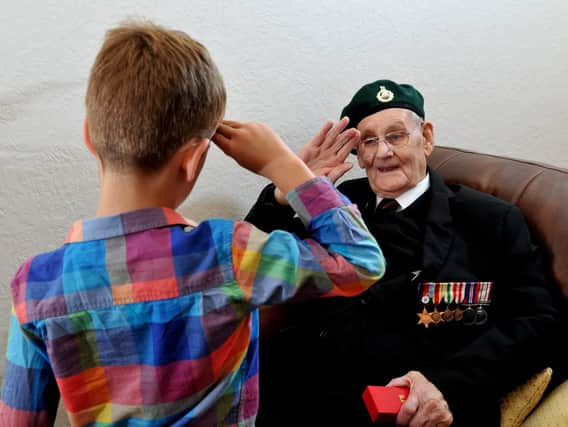Lancashire veteran was afloat amid a deadly sea of mines on D-Day


The sheer number of ships being blasted by bombs and swallowed by the sea still burns in his memory.
John “Chippy” Dowling, who lives in Buckshaw Retirement Village, was 23 years old when he took part in the second wave of landings following D-Day, June 6, 1944.
Advertisement
Hide AdAdvertisement
Hide AdHe worked for the Royal Marines as a signaller receiving messages from the British Army by flag or in Morse Code.
Born in London, John transferred from the Territorial Army in 1939, completing training in Chatham and graduating from the Royal Marine School of Signals.
On June 7, 1944, he landed with the Royal Marines at Normandy’s Gold Beach, at Val Sur Mer, to provide reinforcement to the British 50th Infantry Division, which had advanced inland.
Barrage balloons dotted a grey, cloudy sky as men, vehicles and supplies arrived at the beach.
Advertisement
Hide AdAdvertisement
Hide AdRecalling his approach to shore, John, now 98, says: “There was a lot of firing going on and quite a few British ships were sunk. I can see them in my head now, not a big distance away from where we were.
“I’m not sure if they were exposed but they’d been hit. About 25 went down near me. They were amazingly close. Mostly I saw German boats sink, but one or two got away at top speed.”
At 9.50am on the day before, Royal Marine Commando 47 arrived in 14 landing craft at Gold Beach, in the sector code-named JIG near the town of Asnelles.
The sea was heavy and crowded, and the boats were forced to manoeuvre through uncleared mines. Nazi shells, steel girders and the dreaded mines sunk five craft and damaged five more, and the water teamed with men, swimming and wading ashore under gun fire. Out of a unit strength of just 420, 76 were killed, drowned, wounded or missing.
Advertisement
Hide AdAdvertisement
Hide Ad“Hitler’s soldiers were firing at us as we landed. They would switch on their gun and spray a lot of bullets. Quite a few of our men were hit in the top part of their body as they waded through the sea,” John adds.
“But we swam under the water and then came up and shot some of the German troops.
“The beach was loaded with mines and there were so many explosions. Planes were dropping bombs and firing bullets. I could also hear Nazi tanks firing at British ships, which in turn were mowing down German soldiers. We did do a lot of damage.”
In the afternoon of June 7 – the day John arrived at shore – 47 Commando launched Operation Aubery. Supported by naval gunfire and fighter bombers, the Marines marched nine miles west to liberate the Nazi-occupied Port-en-Bessin, a vital point for delivering fuel from England for the advance through France. But as they moved to the west of the harbour town, two
Advertisement
Hide AdAdvertisement
Hide AdGerman gunboats opened fire with their machine guns, killing 11 commandos and wounding 14 others in just a few minutes.
The Marines battled fierce resistance – snipers, minefields, heavily manned bunkers, machine gun nests and hidden flamethrowers – until the port was seized the following evening and the men succeeded in linking up with the Americans from the nearby Omaha Beach.
It wasn’t the only triumph on Gold Beach that day. By mid-afternoon, the British 50th Infantry Division not only had one of the Allies’ strongest beachheads but had also freed the coastal town of Le Hamel from Nazi occupation, after Petard tanks destroyed the sanatorium which held heavy German resistance.
And by evening, the 50th Division had captured the town of Arromanches-les-Bains, with the aim of installing the inflatable Mulberry Harbour breakwater. Named Port Winston, it would allow the Allied forces to land 2.5m men, 500,000 vehicles and 4m tonnes of supplies.
Advertisement
Hide AdAdvertisement
Hide AdAnd troops had also stormed a concrete fortress elevated on a cliff overlooking the Channel between Gold and Omaha Beach.
Planes and ships had pounded the cliff side until the death-dealing German gun battery of Longues-sur-Mer had been taken.
Still, each Allied victory came with a heavy price; and amid the chaos of D-Day, John remembers the devastating confusion.
“The Americans were well armed and had a lot of ammunition and as we approached the opposition we were accidentally being fired on by our own side.”
Advertisement
Hide AdAdvertisement
Hide AdDespite facing such trauma while still so young, John did not blame the Germans for the atrocities of war.
“I didn’t hate them,” he explains.
“They didn’t want to fight. They were just humans like you and me. In fact, a family friend of mine was once a German prisoner of war.”
It’s a sentiment which seems to be shared with many D-Day veterans and many in the British military.
Maggie Harrison, John’s daughter, says: “German war prisoners were given the same treatment if they were wounded or in hospital as British soldiers. And I was surprised to see a lot of Germans in British war graves when we went over to visit Normandy.”
Advertisement
Hide AdAdvertisement
Hide AdUnlike many of the men buried there, John was one of the lucky ones who returned home from war.
He was demobbed in January 1953 with around £100 gratuity and moved to Portsmouth with his wife Isobel where he took on a newspaper delivery round, before running a shop at the Bickleigh Barracks.
He later managed two shops in Plymouth and has lived in the Chorley area for the past 10 years. His career in later life might have been a peaceful one, but during war time, John’s safe return home was a blessing Maggie’s family never thought they would receive.
She adds: “People would say the D-Day soldiers wouldn’t come back so when Dad came home my sister wouldn’t go to him because she didn’t think he was real.”